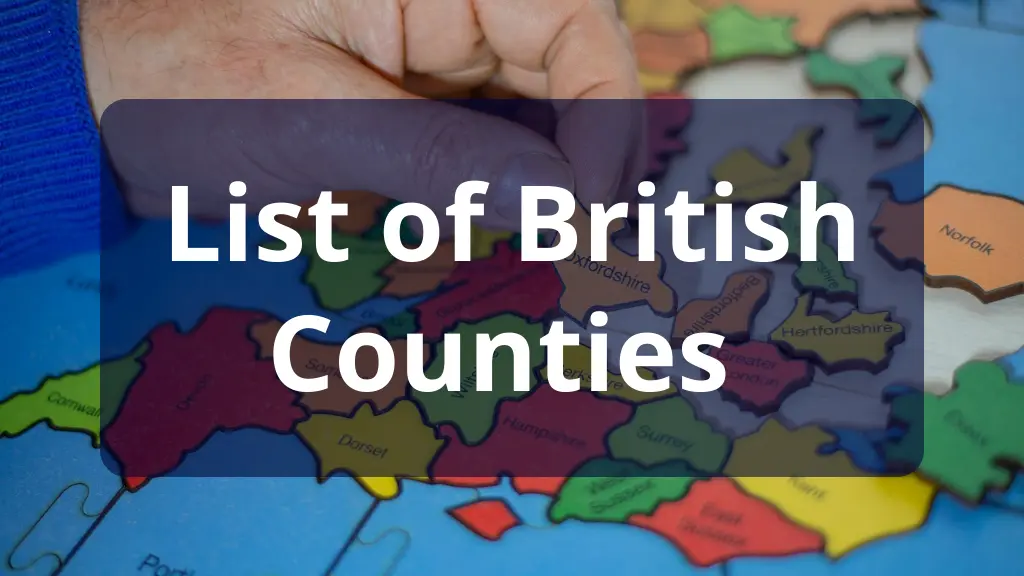Understanding the List of British Counties provides valuable insight into the geography, culture, and history of the United Kingdom. Each county holds its own identity, traditions, and significance, shaping the diverse landscape of Britain. From the bustling counties of London and Greater Manchester to the tranquil rural stretches of Cornwall and Cumbria, every county contributes uniquely to the nation’s fabric. This article offers a detailed explanation of each while also addressing common questions to help readers better understand the regions that make up the UK.
The Importance of British Counties
British counties are more than just administrative regions; they reflect centuries of heritage, governance, and identity. Many counties maintain strong local pride and cultural traditions, making them important both historically and in modern times. The List of British Counties is often referenced by travelers, historians, students, and residents seeking to appreciate the diversity across England, Scotland, Wales, and Northern Ireland.
England Counties
Bedfordshire
A small but diverse county with Luton as its major town, Bedfordshire mixes rural beauty with modern industry. It is known for the Chiltern Hills and historical estates.
Berkshire
Famous for Windsor Castle and royal connections, Berkshire combines heritage with modern business hubs such as Reading. Its River Thames landscapes add to its charm.
Buckinghamshire
Known for the Chiltern Hills and stately homes, Buckinghamshire balances countryside with urban development like Milton Keynes, making it a vibrant county.
Cambridgeshire
Globally renowned for the University of Cambridge, the county thrives on education, science, and research. The Fens highlight its unique natural landscapes.
Cheshire
Chester’s Roman walls and Tudor architecture define Cheshire, while its dairy farming heritage adds to its rural reputation. It also borders vibrant city regions.
Cornwall
Located at Britain’s southwestern tip, Cornwall is famous for its Celtic identity, fishing villages, and surfing beaches. Its culture and landscapes attract millions.
Cumbria
Home to the Lake District, Cumbria offers mountains, lakes, and heritage tied to Hadrian’s Wall. It is one of Britain’s most scenic rural counties.
Derbyshire
The Peak District defines Derbyshire with its hills and caves. The county is historically linked to the Industrial Revolution and continues to thrive culturally.
Devon
Devon’s coastlines, Dartmoor, and Exmoor make it rich in natural attractions. Tourism, fishing, and local traditions such as cream teas add to its appeal.
Dorset
Known for the Jurassic Coast, Dorset showcases geological wonders and picturesque villages. Its slower pace of life appeals to both visitors and residents.
Durham
With Durham Cathedral and Castle as UNESCO sites, the county combines deep history with modern academic excellence at Durham University.
Essex
A county of contrasts, Essex has Roman heritage in Colchester and coastal retreats like Southend. It also benefits from proximity to London.
Gloucestershire
The Cotswolds highlight Gloucestershire’s beauty, while Cheltenham and Gloucester reflect its cultural and historical significance.
Greater London
A global hub of finance, politics, and culture, Greater London contains iconic landmarks like Buckingham Palace and the Houses of Parliament.
Greater Manchester
Known for its music, sports, and industrial past, Greater Manchester has become a thriving urban center with strong cultural influence.
Hampshire
Hampshire features the New Forest, ancient Winchester, and maritime cities like Southampton and Portsmouth, offering a blend of history and commerce.
Herefordshire
Rolling hills, cider orchards, and the famous Hereford cattle define this rural county, where farming traditions remain strong.
Hertfordshire
Close to London, Hertfordshire balances suburban living with history, from St Albans Cathedral to Warner Bros. film studios.
Kent
Known as the Garden of England, Kent features orchards, Canterbury Cathedral, and the iconic White Cliffs of Dover.
Lancashire
With a mix of industrial towns and seaside resorts like Blackpool, Lancashire blends cultural heritage with a proud local identity.
Leicestershire
Home to the discovery of King Richard III, Leicestershire is also known for its multicultural cities and rolling rural landscapes.
Lincolnshire
Famous for its flat Fens, Lincolnshire thrives on farming. Lincoln Cathedral and historic towns highlight its medieval heritage.
Merseyside
Liverpool dominates Merseyside with its music, football, and maritime past. The county blends global culture with working-class traditions.
Norfolk
Norfolk’s Broads, coastline, and medieval Norwich make it distinct. Its farming and seaside tourism remain key to its character.
Northamptonshire
Known as the “county of spires and squires,” Northamptonshire has historic estates, churches, and a strong link to motorsport.
Northumberland
Bordering Scotland, Northumberland is famous for Hadrian’s Wall, castles, and rugged coastlines, offering dramatic scenery and history.
Nottinghamshire
The legend of Robin Hood defines Nottinghamshire, with Sherwood Forest and Nottingham Castle adding to its cultural fame.
Oxfordshire
Home to Oxford University, the county also boasts the Cotswolds and Blenheim Palace, mixing academia, heritage, and rural beauty.
Shropshire
Bordering Wales, Shropshire has rolling hills, historic towns, and Ironbridge Gorge, the birthplace of the Industrial Revolution.
Somerset
Known for Glastonbury Festival, Cheddar cheese, and Bath’s Roman history, Somerset is both traditional and dynamic.
Staffordshire
Famous for pottery, the Peak District, and Alton Towers, Staffordshire balances industry with leisure and natural beauty.
Suffolk
Picturesque villages, medieval churches, and a scenic coastline define Suffolk, making it a favorite for cultural tourism.
Surrey
Close to London, Surrey is affluent and green, with stately homes, the Surrey Hills, and modern commuter towns.
Sussex (East and West)
The South Downs and seaside towns like Brighton and Hastings define Sussex. It also has historic ties with castles and coastal trade.
Warwickshire
Best known as Shakespeare’s birthplace in Stratford-upon-Avon, Warwickshire mixes cultural heritage with rolling countryside.
Wiltshire
Home to Stonehenge and Salisbury Cathedral, Wiltshire blends prehistoric heritage with rural charm.
Worcestershire
Known for Worcester sauce, the Malvern Hills, and historic cathedrals, Worcestershire balances food culture and landscapes.
Yorkshire (North, South, West, East Riding)
Yorkshire is the largest historic county, with national parks, historic cities, and a strong cultural identity that makes it iconic.
Scotland Counties
Aberdeenshire
A county of mountains, coastlines, and castles, Aberdeenshire is also known for whisky distilleries and North Sea energy links.
Angus
Rich farmland and the historic town of Arbroath define Angus, alongside coastal landscapes and strong fishing traditions.
Argyll and Bute
With islands, lochs, and highlands, Argyll and Bute is scenic and historic, playing a major role in Scotland’s Gaelic culture.
Ayrshire
Ayrshire is associated with poet Robert Burns, golf, and coastal resorts. It mixes cultural heritage with rural life.
Dumfries and Galloway
Known for its rolling hills and literary links, Dumfries and Galloway has historic abbeys, castles, and natural beauty.
Edinburgh
Scotland’s capital, Edinburgh combines medieval Old Town, Georgian New Town, and cultural festivals with political importance.
Fife
Fife has historic St Andrews, the birthplace of golf, alongside coastal villages and industrial towns.
Glasgow (City)
A cultural powerhouse, Glasgow is famous for its architecture, universities, and vibrant arts and music scene.
Highland
The Highlands are iconic for mountains, lochs, and Gaelic heritage, attracting global tourism to Scotland’s rugged landscapes.
Perth and Kinross
A county of rivers, glens, and history, it is often called the “Gateway to the Highlands.”
Stirling
Stirling is defined by its castle, Wallace Monument, and historic battles, central to Scotland’s story.
Wales Counties
Anglesey
An island county, Anglesey is known for its coastline, historic sites, and Welsh cultural traditions.
Brecknockshire
Brecknockshire features the Brecon Beacons, a national park offering scenic beauty and outdoor activities.
Caernarfonshire
Dominated by Snowdonia, Caernarfonshire is rich in castles, mountains, and Welsh culture.
Cardiganshire
A historic county on the west coast, Cardiganshire has a strong Welsh identity and coastal beauty.
Glamorgan
Once industrial, Glamorgan includes Cardiff, the Welsh capital, and coastal resorts, blending heritage and modern life.
Monmouthshire
Bordering England, Monmouthshire mixes castles, valleys, and strong cultural traditions.
Pembrokeshire
Known for its national park and coastline, Pembrokeshire is one of the most scenic counties in Wales.
Northern Ireland Counties
Antrim
Home to Belfast and the Giant’s Causeway, Antrim mixes modern life with natural wonders.
Armagh
Known as the ecclesiastical capital of Ireland, Armagh features cathedrals and orchards.
Down
The Mourne Mountains and coastal towns make Down a county of beauty and history.
Fermanagh
Defined by lakes and waterways, Fermanagh is a rural county with strong natural appeal.
Londonderry
With the historic city walls of Derry and scenic countryside, Londonderry is both cultural and historic.
Tyrone
Rural Tyrone is one of the largest counties, with rolling hills and cultural traditions.
FAQs
How many counties are there in the UK?
The UK has 92 historic counties, though numbers differ depending on whether ceremonial or administrative counties are counted.
Which is the largest county in Britain?
Yorkshire is the largest historic county, with diverse landscapes and strong cultural influence.
What is the difference between historic and ceremonial counties?
Historic counties date back centuries, while ceremonial counties are used for administrative purposes. Both remain culturally significant.
Why are counties important in the UK?
They define communities, heritage, and identity, offering cultural, geographic, and historic context across the nation.
Which counties are most popular for tourism?
Cornwall, Cumbria, Devon, and the Scottish Highlands are among the most visited due to their stunning natural beauty and cultural heritage.
Do counties still matter today?
Yes, counties remain important for cultural pride, local traditions, and tourism, even if administrative boundaries have changed over time.
Conclusion
The List of British Counties reveals the diversity and heritage of the United Kingdom. Each county, whether rural or urban, historic or modern, plays a role in shaping the nation’s identity. From the rugged Highlands of Scotland to the bustling streets of Greater London, the counties of Britain tell a story of culture, tradition, and progress. Appreciating these counties helps us understand the geography, history, and enduring character of Britain.
Related Post:





